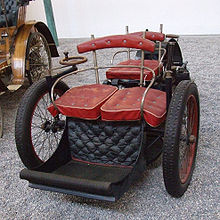London to Brighton Veteran Car Run

The London to Brighton Veteran Car Run (since 2014: Bonhams London to Brighton Veteran Car Run ) is, according to its own statement, the oldest motorsport event in the world. Only vehicles built before 1905 are permitted.
After the repeal of the Red Flag Act , which banned fast driving, the first race from London to Brighton was held in 1896 . The race is known for the fact that only vehicles are allowed that were built before 1905.
history

The first race in 1896, organized by Henry John "Harry" Lawson (1852–1925), became known as The Emanicipation Run ; it was originally the celebration of avid motorists to mark the repeal of the Locomotive Act, which had enforced that vehicles could not go faster than 4 mph (6.4 km / h). This race was the symbolic tearing a red flag by another early motor enthusiasts , the 12th Earl of Winchilsea, 7th Earl of Nottingham Murray Edward Gordon Finch-Hatton (1851-1898), started because of as Red Flag Act known The Locomotive Act required that every motorized vehicle be preceded by a red flag pedestrian. The winner of the race was the French designer Léon Bollée on a Léon Bollée three-wheeler. The race is part of the motorsport year 1896 .
The next event took place in 1927, and it has been held annually since then, with the exception of the war years and the subsequent fuel shortage from 1940 to 1947. This fact makes the run the longest running race. The race has been organized by the Royal Automobile Club since 1930 .
The 1953 film comedy Die fierige Isabella (original title Genevieve ) plays during one of these races.
Course and meaning
The London to Brighton Veteran Car Run is also the largest gathering of veteran vehicles from early automotive history; In 2005, 443 vehicles started. In addition to four-wheeled cars with combustion engines, three-wheelers, steam cars and electric cars are also starting .
The race takes place on the first Sunday in November and starts at sunrise in Hyde Park , London. It essentially follows the A23 national road and ends in Brighton after a distance of 86 km (54 miles). There are two official stops along the way: Crawley and Preston Park, a suburb of Brighton. Preston Park is the official end point of the race. The vehicles then traditionally continue to the Madeira Drive promenade .
The organizers stress that this event is not a race in the strict sense of the word; they don't even publish an order in which the vehicles arrive. Participants must not exceed an average speed of 20 mph (32 km / h). Everyone who arrives before 4.30 p.m. will receive a medal.
The popularity of the race has a significant impact on the prices of collector's vehicles. For oldtimers that can take part in the race due to their early year of construction, higher prices are usually achieved than for only slightly younger models that are not allowed to participate.
For decades, these trips have been more of a touristic show event, many participants and spectators dress in a late Victorian or Edwardian style.
Footnotes
- ↑ Leonard JK Setright: Drive On! A Social History of the Motor Car . Granta Books, London 2004, ISBN 1-86207-698-7 .
Web links
- Official website
- Page of the “Veteran Car Club of Great Britain” about the race ( Memento from February 16, 2006 in the Internet Archive )
- Cuckfield Companion's page on the LBR
- Film about the event 1972 (English)
